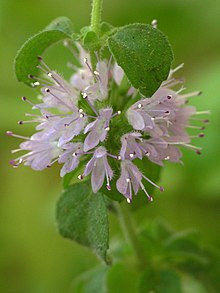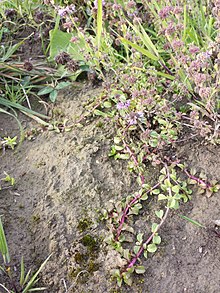Polei mint
| Polei mint | ||||||||||||
|---|---|---|---|---|---|---|---|---|---|---|---|---|

Polei Mint ( Mentha pulegium ) |
||||||||||||
| Systematics | ||||||||||||
|
||||||||||||
| Scientific name | ||||||||||||
| Mentha pulegium | ||||||||||||
| L. |
The pennyroyal ( Mentha pulegium ), also pennyroyal or fleabane (formerly also Flöhkraut ) is called, a plant from the genus mint ( Mentha ) within the family of Labiatae (Lamiaceae). The plant name “Polei”, which has existed since Middle High German times, is based on the Old High German polaia / poleige / pulei and is borrowed from the Latin pulegium .
description
Appearance and leaf
Polei mint is a perennial herbaceous plant that reaches heights of 10 to 50 centimeters. It has underground and above-ground runners that are hairy bald to briefly scattered. It is often red covered. The plant parts smell pungent aromatic. The prostrate to ascending and branched stem is almost bare.
The against-constantly arranged on the stem leaves are stalked short. The simple leaf blade is 0.8 to 3 inches long and 0.3 to 1 inches wide, ovate to narrowly elliptical and narrowed at the base. The light green, simple leaf blade is traversed by one or two to three pairs of arched pinnate veins and hairy on the underside. The leaf margin is indistinctly serrated to almost entire.
Inflorescence, flower and fruit
The flowering period extends from May to September. Many flowers are in 5 to 15 false whorls , which are clearly separated from each other and 10 to 15 millimeters wide. The bracts of the sham whiskers are similar to the stem leaves and almost twice as long as the flowers.
The hermaphrodite flowers are zygomorphic and five-fold with a double flower envelope . The 2.5 to 3 millimeter long sepals are fused tubular and weakly two-lipped (this is where this species differs from all other Mentha clans, where the calyx ends in more or less the same five calyx teeth) with ten nerves. On the outside, the calyx is dense and has short hairs and is closed by a ring of hair when the fruit is ripe. The unequal calyx teeth are a third to a fifth as long as the calyx tube and have eyelashes. The top tooth is bigger than the others. The pink and rarely white crown is 4.5 to 7 millimeters long and ends in obovate corolla lobes of about the same length. The corolla tube has a light ring of hair inside. The four fertile anthers are 0.4 millimeters long.
The Klausen are 0.7 to 0.8 millimeters long, smooth and light brown.
Chromosome number
The number of chromosomes is 2n = 20, but also 10, 30 or 40.
ecology
Polei mint is a hemicryptophyte . Polei mint is also a runners pioneer.
From an ecological point of view, they are funnel-shaped flowers that smell and form nectar . The sex ratio is gynodiözisch or gynomonözisch . In addition to proterandric hermaphroditic flowers, there are also female flowers with stunted stamens. Diptera , also apoids and coleoptera , function as pollinators .
Occurrence and endangerment
Polei mint is widespread from Macaronesia across Europe and the Mediterranean region to northern Iran and northern Ethiopia. In Europe it is a meridional to subtemperate, oceanic floral element . Polei mint occurs rarely in Central Europe on the lower reaches of the Elbe and Weser , on the Middle and Lower Rhine , on the Moselle , the Danube from Regensburg to Vienna, in Burgenland , in Styria , at the foot of the Alps and in the area of Lake Geneva . In Germany it occurs particularly in the main river valleys and is otherwise rare or scattered.
Polei mint was entered in the Red List of Endangered Plant Species in Germany in 1996 in Category 2 = highly endangered. In most of the German federal states it is endangered or threatened with extinction.
In Central Europe it is limited to the colline altitude level . It thrives in locations with a mild winter climate . The Polei Mint colonizes damp meadows, river and lake banks, solidified banks and wet areas on unpaved roads. It occurs on nutrient-rich , lime-poor, humus-rich , rather sandy clay soils and is salt-bearing. In Central Europe it is a character species of the Agropyro-Rumicion association, but also occurs in dwarf rush communities (Isoeto-Nanojuncetea) or in overgrazed Cynosurion communities.
Toxicity and Use
Polei mint is considered to be slightly to poisonous in all parts of the plant.
The main active ingredients are the essential oil contained in it with 1 to 2% , which contains 80 to 94% pulegone in addition to piperiton , limonene and other components.
Symptoms of poisoning are choking , vomiting , increased blood pressure , central, anesthetic-like paralysis , and death from respiratory paralysis after larger doses .
Poisoning became known after the use of the drug as an abortion . The pulegon is likely to be responsible for the poisonous effect .
The essential oil has a certain insecticidal effect and is said to be able to drive away fleas. Polei mint enjoys a special reputation as a repellent against insects, especially against fleas. The specific epithet pulegium is derived from the Latin word pulex for flea.
Nowadays, Polei mint is rarely used in the kitchen because it has a very strong taste. A tea made from its leaves is said to have a digestive effect. It can also be used as a mouthwash for gargling. Polei mint contains the poison pulegon , which is why this type of mint can only be used with caution for internal purposes.
Use as a medicinal plant
Pole mint is used as a drug .
Active ingredients are: The essential oil with 15 to 90% pulegone as the main component, besides menthone and piperitone menthol , lamiaceae tannins and flavonoids .
Applications: Pole mint was previously used in folk medicine against digestive problems with flatulence and colic , liver and gallbladder problems and when the menstrual period stopped .
Since pulegon content has since become known to have harmful effects on the liver, the use of the drug as a tea is not recommended today (especially during pregnancy), only the use as a spice is acceptable.
Symptoms of poisoning with fatal outcome have repeatedly been described after the use of the essential oil as an abortifacient . In ancient times, the drug was used as a method of contraception and abortion.
swell
literature
- Siegmund Seybold (Ed.): Schmeil-Fitschen interactive . CD-ROM, version 1.1. Quelle & Meyer, Wiebelsheim 2002, ISBN 3-494-01327-6 .
- Ramón Morales: Mentha . In: Santiago Castroviejo, Ramón Morales, Alejandro Quintanar, Francisco José Cabezas, Antonio José Pujadas, Santos Cirujano (eds.): Flora Ibérica. Plantas Vasculares de la Península Ibérica e Islas Baleares . Vol. XII. Verbenaceae - Labiatae - Callitrichaceae . Real Jardín Botánico, CSIC, Madrid 2010, ISBN 978-84-00-09041-8 , Mentha pulegium , p. 339-340 ( PDF file ).
- Avril Rodway: Herbs and Spices. The most useful plants in nature - culture and use. Tessloff, Hamburg 1980, ISBN 3-7886-9910-8 .
- Heinrich Marzell : Dictionary of German plant names. Volume 3. S. Hirzel, Leipzig 1943, p. 162.
Individual evidence
- ↑ Adoration .
- ^ Friedrich Kluge , Alfred Götze : Etymological dictionary of the German language . 20th edition. Edited by Walther Mitzka . De Gruyter, Berlin / New York 1967; Reprint (“21st unchanged edition”) ibid 1975, ISBN 3-11-005709-3 , p. 558.
- ↑ a b c d e f g h i j k Polei mint. In: FloraWeb.de.
- ↑ a b Erich Oberdorfer : Plant-sociological excursion flora for Germany and neighboring areas . With the collaboration of Angelika Schwabe and Theo Müller. 8th, heavily revised and expanded edition. Eugen Ulmer, Stuttgart (Hohenheim) 2001, ISBN 3-8001-3131-5 , pp. 816 .
- ↑ Rafaël Govaerts (ed.): Mentha pulegium. In: World Checklist of Selected Plant Families (WCSP) - The Board of Trustees of the Royal Botanic Gardens, Kew . Retrieved January 10, 2018.
- ↑ a b c Dietmar Aichele, Heinz-Werner Schwegler: The flowering plants of Central Europe . 2nd Edition. tape 4 : Nightshade plants to daisy plants . Franckh-Kosmos, Stuttgart 2000, ISBN 3-440-08048-X .
- ^ Rudolf Schubert , Klaus Werner, Hermann Meusel (eds.): Exkursionsflora for the areas of the GDR and the FRG . Founded by Werner Rothmaler. 13th edition. tape 2 : vascular plants . People and knowledge, Berlin 1987, ISBN 3-06-012539-2 (area).
- ↑ a b c d e f g h i Lutz Roth, Max Daunderer, Kurt Kormann: Toxic Plants - Plant Poisons. Occurrence, effect, therapy, allergic and phototoxic reactions. With a special section about poisonous animals. 6th, revised edition, special edition. Nikol, Hamburg 2012, ISBN 978-3-86820-009-6 .
- ↑ a b c d e f g Ingrid and Peter Schönfelder : The New Handbook of Medicinal Plants, Botany Medicinal Drugs, Active Ingredients Applications ., Franckh-Kosmos Verlag GmbH & Co. KG, Stuttgart, 2011, ISBN 978-3-440-12932-6
- ↑ Robert Jütte: History of Contraception . Munich 2003, p. 68 f .
Web links
- Polei mint. In: FloraWeb.de.
- Polei mint . In: BiolFlor, the database of biological-ecological characteristics of the flora of Germany.
- Mentha pulegium L. In: Info Flora , the national data and information center for Swiss flora .
- Thomas Meyer: Mint data sheet with identification key and photos at Flora-de: Flora von Deutschland (old name of the website: Flowers in Swabia )
- Profile on Heilkraueter.de .




